PU/EPOXY CONCRETE INDUSTRIAL FLOORING
PU Concrete – concrete flooring company in Bangladesh
PU Concrete flooring company in Bangladesh. his cost effective because it is long lasting, quick and practical to install and meets all the needs of modern processing industry. It is a unique suite of products based upon the PU Concrete heavy duty polyurethane resins which enjoy an unequalled reputation for performance built up over four decades of use throughout the food, beverage, pharmaceutical and chemical industries.
These flooring systems have an exceptional resistance to aggressive chemicals, heavy impact and thermal shock. Thousands of satisfied local and multinational satisfied clients in Bangladesh and worldwide. With PU floor coating, we are providing long-term, without problem and cost-effective, flooring protection, reasonable price in the most difficult environments in Bangladesh. Undoubtedly, PU floor paint is the best flooring structure of choice for sharp end users, Engineers, consultants requires, suppliers and contractors in Bangladesh and worldwide.
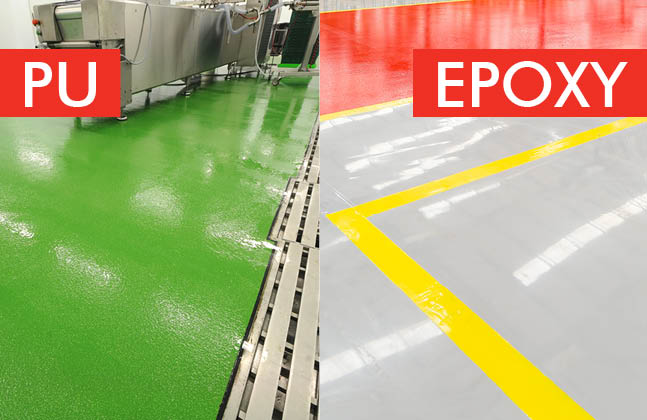
Polyurethane (PU) Concrete Flooring
Polyurethane or PU Concrete Developed more than many years ago in Europe as the most demanding industrial environment, PU technology is the original polyurethane flooring solution that provides a powerful layer of protection for both new and existing concrete surfaces.
PU Concrete flooring company in Bangladesh – The World’s Toughest Floor
Urethane cement floorings, urethane modified concrete, PU concrete, Poly Urethane Concrete and Urethane concrete or simply, PU-concrete. The chemistry is the combination of cement and waterborne urethane. The Polyurethane concrete composition has a similar elasticity as like concrete.
Enviroshield is Authorized Distributor and applicator of World best construction chemicals company VIACOR, DUCON, CIPY POLYURETHANE, DR.FIXIT BASF and many of world leading construction chemicals company. we are recipient of the prestigious BASF Performance Flooring Master Contractor Award for 2014, 2015 –an honor bestowed to only a selective flooring contractor Globally and a testimony to the hard work, complexity of knowledge and high standards of our consultants and installation teams.
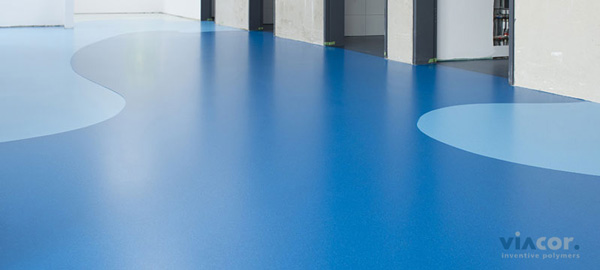
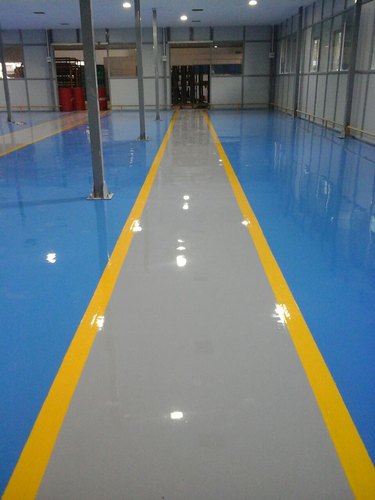
Key Benefits
- Durable: excellent impact and wear resistance. Many 20–30 year old PU Concrete floors in aggressive environments are still in service.
- Fast application and curing: even at low temperatures. Specifications are available that are fully serviceable after only 5 hours at 10°C, making it ideally suited for refurbishment work.
- Fast application and curing: even at low temperatures. Specifications are available that are fully serviceable after only 5 hours at 10°C, making it ideally suited for refurbishment work.
- Moisture tolerant: can be installed onto 7 day old concrete without the need for special primers, helping to maintain program on fast track projects.
- Thermal shock resistance: withstands spillages up to 150 °C depending upon specification.
- Hygiene: cleanable to the same standard as stainless steel and does not support biological growth, so helping to maintain hygiene standards.
- Chemical resistance: from strong acids to alkalis, fats, oils and solvents which can rapidly degrade other types of resin flooring.
- Clean and safe: for your workers, your products and the environment. Certified with the Eurofins Indoor Air Comfort Gold standard for low emissions.
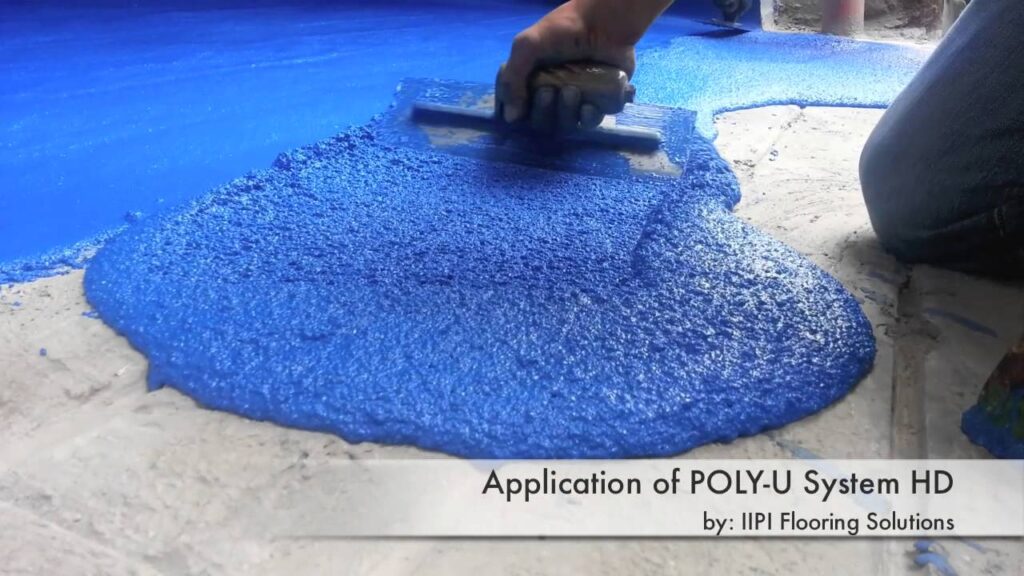
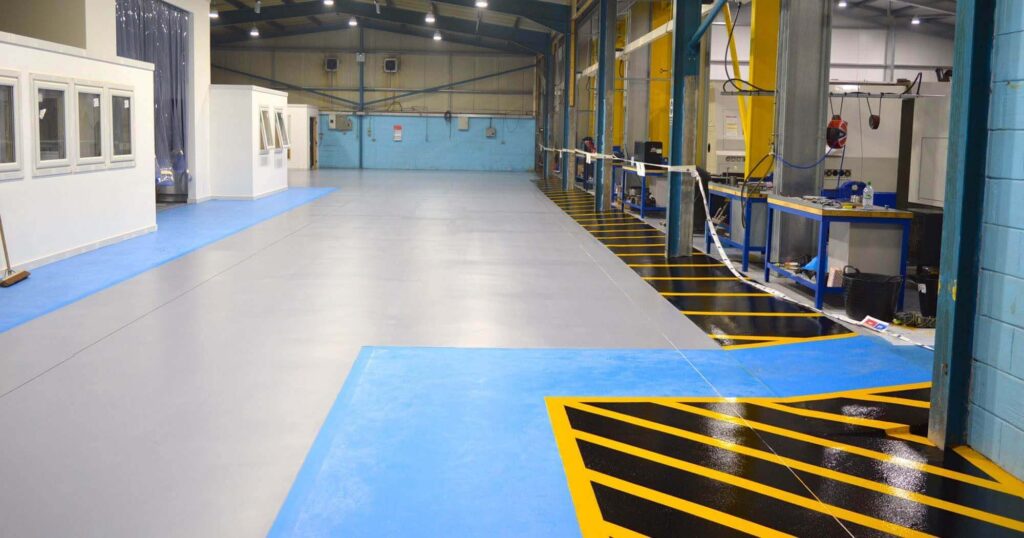
EnviroShield Polyurethane (PU) Floorings
Almost all the industries in India and Bangladesh today have epoxy/PU floorings in their plant area in order to provide a seamless, joint-less aesthetic, chemical-resistant, hygienic, and dustfree atmosphere. A survey in the USA on epoxy/PU floorings has indicated that about 20% of the problems were due to the wrong selection of material/thickness, 60% due to the wrong application, and 20% due to the poor quality of the products. Hence it is important to divide the discussion into three parts:
- Pre-installation guide-lines and checks
- Installation procedures
- Post-installation practices
Pre-installation of guidelines for the honorable customers and Engineers
Selection the Right Products :
Various authors have deliberated on which kind of material to choose for which applications. This is therefore not covered here. The major difference between epoxy and PU systems is that PU is more flexible and hence is more suitable in high-impact areas.
Selection the right thickness:
It is very important to arrive at the correct thickness of flooring to provide optimum service to the required traffic conditions. The higher the thickness, the higher the durability, and the higher will be the cost. Hence, it is pertinent to calculate the right thickness
Analysis the requirement :
This is the most important part of the process for the selection of right product as well as the right application methods. Obviously, a single product cannot meet all the requirements and hence the customer has to allot a priority for each requirement. Light duty flooring can be laid from 500 microns to 1 mm, medium duty at 1 mm to 2 mm and heavy duty varies from 3 mm to 5 mm. All the above parameters can be said to resist the following four broad categories:
Mechanical effects:
Static and dynamic loads, abrasion, impact, vibration, skidding, conductive, or antistatic etc.
Chemical effects:
Oil, grease, chemicals, soluble salts, cleaning agents, solvents
Environmental effects:
Thermal exposure such as heat or cold, UV, and other weather conditions, noise
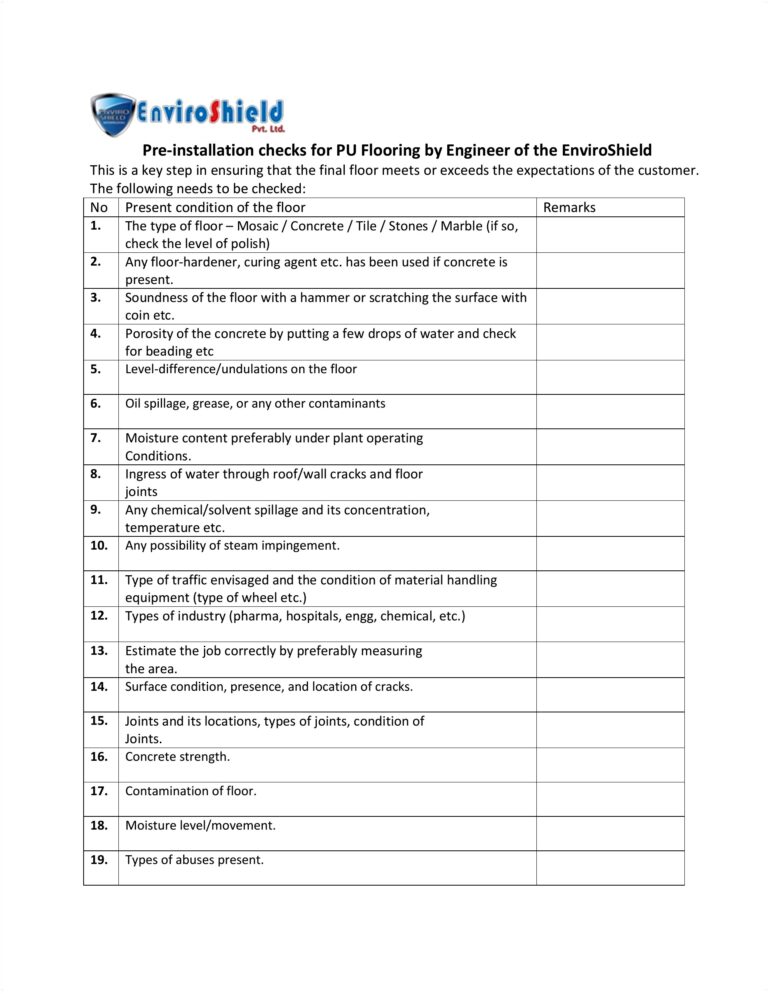
Step of Work and Procedure of EnviroShield PU Flooring concrete flooring company in Bangladesh
Moisture Testing
Moisture in the concrete or rising moisture from subsoil has been the single most contributing factor for failure due to bubbles. Moisture doesn't just mean water droplets, it could include high humidity. Some coatings shouldn't be applied when humidity levels are high. More obvious sources of serious moisture are things like rising moisture through concrete pores, the higher moisture content in new concrete, standing water puddles on a concrete slab, or, even more likely, a damp or even saturated surface
- Surface dry doesn't mean really dry. Surface moisture content can be measured by means of a handheld moisture meter and the thumb rule is that the moisture content should be less than 5% to allow impermeable coatings to be laid. However, surface moisture is only an indicative test and is not sufficient to test rising moisture.
- There can be (and often is) a high moisture content hidden just below the surface. The standard test is to tape a 1.2 m by 1.2 m plastic sheet to the concrete and see if visible moisture collects under the plastic. Some of the modern epoxies can be applied to wet or damp surfaces but generally a moisture rich surface means no possibility of coating.
- Post-installation practices
Check for Oil/Grease
Generally coatings do not stick to greasy, oily, waxy surfaces. This includes many kinds of plastic surfaces. Oily surfaces can be tricky, just grinding the surface is often not good enough, as oil within the concrete is bound to rise to the surface before the primer has the chance to stick. Even on what seems like a non-greasy surface, any coatings will 'bead-up' leaving behind hollow, coating-less circles or voids.
Check for Dust, Salts etc
This is one of the neglected steps and can lead to disastrous consequences. Coatings may stick to the dust but not to the base floor and can lead to de-bonding. Salts and/or minerals either deposited out on the surface from the curing of fresh concrete or from the evaporation of seawater on concrete, or steel can quickly ruin a coating.
All the above pre-installation steps are very important activities that should not be ignored to ensure a long-lasting epoxy/PU flooring solution.
The thermal surface preparation is required for following
- Recommended for oil soaked floors
- Application involves burning of oil through special torch by flame.
- Primer application should take place in hot condition only for better penetration
Priming
After the surface preparation, the second step is to ensure that the surface is primed properly. The application of priming is as important as that of surface preparation in ensuring the longevity of flooring and is most likely to be ignored by most of the contractors. As may already be known, concrete consists of micro-pores that typically do not allow penetration of fillerrich epoxy coatings. Hence, it is essential that the initial bonding is achieved by an epoxy primer that contains only resin and hardener and is of such viscosity so as to penetrate the pores of concrete thus creating a bond equivalent to that of spiked shoe on a soft floor. Thus, the concrete pores that are opened up by surface preparation get filled by a proper epoxy primer and increase the durability of the topping multi-fold. Depending on the porosity of the concrete, viscosity of the primer shall be properly chosen. primers will not agree with vitrified tiles, polished marble/granite etc., these call for specially formulated primers. Once the primer layer is cured, which typically can take 4 to 12 h, depending on temperature and humidity, screed underlay has to be applied. It is strongly advised that screed underlay is applied over primer not later than 24 h. Once the primer layer is hardened, the interphase bond between screed and primer can diminish. In case of delay in screed application, it is advisable to wipe the primed surface with solvents like Xylene, MIBK etc. When the total thickness of the floor topping exceeds 3 mm, it is preferable to do a 2 mm self-leveling screed underlay followed by 1 mm self-leveling topping instead of 3 mm topping together. Though this concept is being questioned by many, the argument in favor of doing a screed underlay has the following merits
- Leveling of undulated floors is much easier
- Leveling of undulated floors is much easier
- In essence, it can also reduce the overall price of the system.
Topping
Execution of topping is very similar to that of execution of self-leveling underlay except the fact that topping contains a forth component i.e. pigment. Pigment needs to be added to component A (resin part); mixed well and component B & C are to be added sequentially. Proper mixing machines need to be used to ensure homogeneity of the system and consequent development of desired properties. Do not allow mechanical movement for 48 h and chemical exposure for 7 days.
Post-installation practices
- Clean the floor regularly with a mop at least once a day.
- Do not allow any loose sharp particles to be strewn on the floor and ensure to remove the same immediately
- Check the wheels of the vehicles regularly to ensure that there are no sharp particles adhering on the wheels.
- Rectify the leaking pipes and joints immediately (e.g. Oil carrying pipes in machines).
- Rectify the leaking pipes and joints immediately (e.g. Oil carrying pipes in machines).
- Avoid dragging heavy loads like machinery, wooden crates etc.
- Periodically inspect the areas and rectify damaged areas immediately.
- Do not clean epoxy floors with acid.
Conclusion
Epoxy / PU floorings have been found to give an excellent service in various industries such as pharmaceuticals, food, automobile/auto ancillaries, textile, electronic, and electrical industries, light engineering, chemical industries, etc. However, it is important to ensure that the execution and maintenance has been done as per various standard procedures. EnviroSield assured the latest and the best products the industry has to offer in all our services. We use our best products, technology and strategy to help clients solve their toughest challenges. We are unified in our mission of helping people along their journey with deep transparency, honesty and trust.

